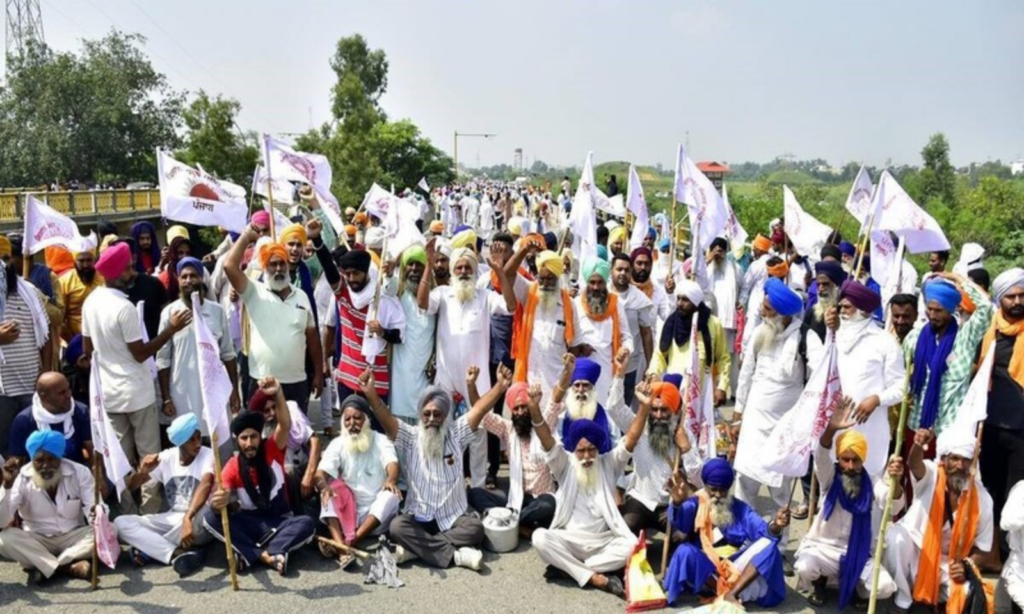On 13 February, several farmers’ unions from Punjab, Haryana, and Uttar Pradesh relaunched extensive protests against the central government’s perceived inaction on longstanding issues. The situation remains fluid, with the demands of the protesting farmers yet to be resolved.
History
The previous Indian Farmers’ Protest was a significant movement by farmers in India that began in late 2020 and continued into 2021. The protests were primarily against three new agricultural reform laws passed by the Indian government in September 2020. The protests garnered widespread attention both domestically and internationally, with farmers organizing massive demonstrations, sit-ins, and road blockades, particularly around the borders of Delhi.

Due to failed negotiations, the protests continued into 2021. Under mounting pressure from the nationwide protests, the government agreed to temporarily suspend the implementation of the laws in January 2021 and proposed to put them on hold for 18 months.
What is happening now?
Starting with extensive public gatherings in Noida on 7 and 8 February, farmers began a protest march towards the Parliament in Delhi. This led to the issuance of a traffic advisory across Gautam Buddh Nagar and the enforcement of Section 144, which restricted gatherings of 5 or more people. Later, on 12 February, Section 144 was expanded to cover Delhi, further limiting assemblies to groups of 4 or fewer individuals and prohibiting processions, demonstrations, rallies, or the carrying of firearms.The prohibitory orders are likely to remain in force until at least 12 March.
On 13 February, farmers from Punjab, Haryana, and Uttar Pradesh began their “Dilli Chalo” (March to Delhi) rally over various demands. The farmers were set to gather at entry points around Delhi and enter the city from Shambhu, Khanauri, Dabwali, Singhu, Ghazipur, and Tikri borders. The demonstrating farmers and the Haryana Police clashed at the Punjab-Haryana Shambhu border. Police forces fired tear gas for several days in a row in order to disperse the crowd. Many were arrested and vehicles were seized.

On 14 February, Singhu and Tikri borders were sealed, with multilayer barricades erected to deter protesting farmers, leading to further clashes and heightened tensions. On 16 February, farmers’ unions announced a nationwide shutdown from 06:00-16:00 hours local time, affecting public and private institutions, banks, shops, and markets, with closures of national highways and state borders in Punjab, along with the suspension of public transport services.
On 21 February, a protesting farmer was killed in the clashes at the Punjab-Haryana border in KhanauriPunjab-Haryana border at Khanauri.. The protest was put on hold until 23 February. Due to escalating tensions, internet and bulk SMS services were suspended in seven districts of Haryana.
On 26 February, Farmers on Monday took out a tractor rally near the Yamuna Expressway in Uttar Pradesh’s Gautam Buddh Nagar district. Noida Police issued a traffic advisory for commuters and warned of massive traffic congestion at many places, including the Delhi-Noida border.
What does the Future Hold?
As of 27 February, at least 5 farmers have died amid clashes and due to other reasons at the Shambhu and Khanauri borders. Until 29 February, the farmers will camp near different locations on the inter-state boundaries between Delhi, Punjab, Haryana and Uttar Pradesh. Their course of action is yet to be announced. However, sporadic unrest has resulted in perpetual delays on major highways and roads to and from Delhi owing to severe congestion caused by elaborate security arrangements, sealed border points, lane closures or even heavily barricaded roads.

As rounds of negotiations continue, it is currently uncertain if and when the protests will subside. The agitation is expected to persist in the coming weeks, warranting increased caution for travellers in affected regions. If travelling in these states, anticipate additional security checkpoints, and maintain clear and transparent communication with officials. Plan your outings and avoid areas of large gatherings. Allow adequate time for road travel or consider using alternate routes to avoid inconvenience. Follow any other advice from local authorities, particularly during curfew hours. Prepare for interruptions in cellular and internet services.
Stay updated with Sitata’s Travel Safety Alerts.



